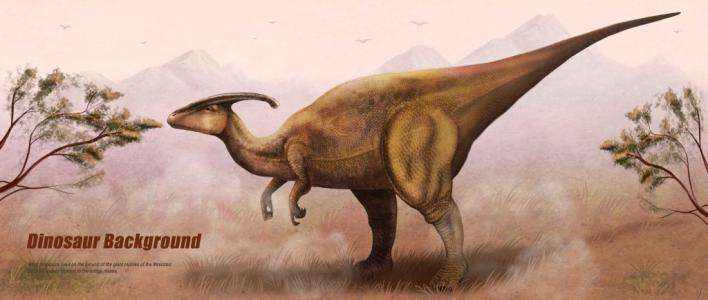Dinosaur Knowledge Tips Parasaurolophus
Release time:2017/11/15 9:40:00

Parasaurolophus ( PARR-ə-saw-ROL-ə-fəs or PARR-ə SAW-rə-LOH-fəs; meaning "near crested lizard" in reference to Saurolophus) is a genus of ornithopod dinosaur that lived in what is now North America during the Late Cretaceous Period, about 76.5–74.5 million years ago. It was a herbivore that walked both as a biped and a quadruped. Three species are universally recognized: P. walkeri (the type species), P. tubicen, and the short-crested P. cyrtocristatus. Additionally, a fourth species, P. jiayensis, has been proposed, although it is more commonly place in the separate genus Charonosaurus. Remains are known from Alberta (Canada), New Mexico and Utah (United States), and possibly Heilongjiang, (China). The genus was first described in 1922 by William Parks from a skull and partial skeleton found in Alberta.
Parasaurolophus was a hadrosaurid, part of a diverse family of Cretaceous dinosaurs known for their range of bizarre head
adornments. This genus is known for its large, elaborate cranial crest,
which at its largest forms a long curved tube projecting upwards and
back from the skull. Charonosaurus from China, which may have been its closest relative, had a similar
skull and potentially a similar crest. Visual recognition of both
species and sex, acoustic resonance, and thermoregulation have been proposed as functional explanations for the crest. It is one
of the rarer hadrosaurids, known from only a handful of good specimens.

Like most dinosaurs, the skeleton of Parasaurolophus is incompletely known. The length of the type specimen of P. walkeri is estimated at 9.5 m (31 ft), and its weight is estimated at 2.5 tonnes (2.8 short tons). Its skull is about 1.6 m (5 ft 3 in) long, including the crest, whereas the type skull of P. tubicen is over 2 m (6 ft 7 in) long, indicating a larger animal. Its single known forelimb was relatively short for a hadrosaurid, with a short but wide shoulder blade. The thighbone measures 103 cm (41 in) long in P. walkeri and is robust for its length when compared to other hadrosaurids. The upper arm and pelvic bones were also heavily built.
Like other hadrosaurids, it was able to walk on either two legs or
four. It probably preferred to forage for food on four legs, but ran on
two. The neural spines of the vertebrae were tall, as was common in lambeosaurines; tallest over the hips, they increased the height of the back. Skin impressions are known for P. walkeri, showing uniform tubercle-like scales but no larger structures.
As a hadrosaurid, Parasaurolophus was a large bipedal/quadrupedal herbivore, eating plants with a sophisticated skull that permitted a grinding motion analogous to chewing.
Its teeth were continually being replaced; they were packed into dental
batteries containing hundreds of teeth, only a relative handful of
which were in use at any time. It used its beak to crop plant material,
which was held in the jaws by a cheek-like organ. Vegetation could have been taken from the ground up to a height of around 4 m (13 ft). As noted by Bob Bakker, lambeosaurines have narrower beaks than hadrosaurines, implying that Parasaurolophus and its relatives could feed more selectively than their broad-beaked, crestless counterparts.

Parasaurolophus is known from three certain species, P. walkeri, P. tubicen, and P. cyrtocristatus. All of them can be distinguished from each other, and have many differences. The first named species, therefore the type, is P. walkeri. One certain specimen, from the Dinosaur Park Formation is referred to it, but many more are almost certainly referable. Like stated above, it is different from the other two species, with it having a simpler internal structure than P. tubicen, a straighter crest and different internal structuring than P. cyrtocristatus.
The next named species is P. tubicen, which is the largest of the Parasaurolophus species. It lived in New Mexico, where three specimens are known, and can be differentiated from its other species. It possesses a long and straight crest, with a very complex interior compared to the other species. All known specimens of P. tubicen come from the De-Na-Zin Member of the Kirtland Formation.
In 1961, the third species, P. cyrtocristatus was named by John Ostrom. Its three known specimens, have been found in the Fruitland and Kaiparowits formations from Utah and New Mexico. The second specimen, the first known from the Kaiparowits Formation, was originally unassigned to a specific taxon. Of the Parasaurolophus species, P. cyrtocristatus it is the smallest, and has the most curved crest. Because of its possession of the two above features, it has often been speculated that it was a female of P. walkeri or P. tubicen, which were males, although P. tubicen lived approximately a million years later. As noted by Thomas Williamson, the type material of P. cyrtocristatus is about 72% the size of P. tubicen, close to the size at which other lambeosaurines are interpreted to begin showing definitive sexual dimorphism in their crests (~70% of adult size). Even though many scientists have supported the possible fact of P. cyrtocristatus being a female, many other studies have found that it is not, because of the differences in age, distribution, and the large differences in the crest and its internal structure.
A study published in PLoS ONE in 2014 found that one more species could be referred to Parasaurolophus. This study, led by Xing, found Charonosaurus jiayensis was actually nested deeply inside Parasaurolophus, which created the new species P. jiayensis. If this species is indeed inside Parasaurolophus, then the genus lasted until the K-Pg extinction, and is known from two continents.

from Wikipedia